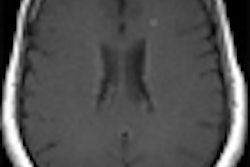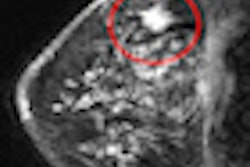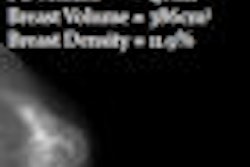Breast lesions that are classified as "probably benign" on breast MRI scans turn out to be malignant at about the same rate as similarly classified lesions on conventional mammography images, according to a study published in the June issue of Radiology.
The data, from the American College of Radiology Imaging Network (ACRIN) 6667 study, should give radiologists reviewing breast MRI scans some reassurance that following the established clinical protocol in mammography of short-term surveillance rather than biopsy won't result in missed cancers.
The study was published by a research team led by Dr. Susan Weinstein and colleagues from the University of Pennsylvania Medical Center in Philadelphia (Radiology, June 2010, Vol. 255:3, pp. 731-737).
Category 3 lesions
The researchers focused on lesions classified as category 3, or probably benign, on the BI-RADS breast reporting lexicon. Although the MRI version of BI-RADS doesn't give specific imaging features for category 3 lesions, if MRI's results are comparable to mammography, the lesions have a high likelihood of being benign and can be tracked rather than biopsied.
"How often malignancy is found in probably benign lesions has been pretty well studied for mammography," Weinstein said. "The accepted range for malignancy detected in mammographic BI-RADS category 3 lesions is less than 2%. But the percentage of malignancy found in BI-RADS category 3 MR imaging lesions has been an unknown."
The study included 106 women who had been classified as having a BI-RADS category 3 lesion as their highest-scoring lesion at MRI; from these 106 patients, 145 BI-RADS 3 lesions were found. A 1.5-tesla or greater MRI unit with a dedicated breast coil was used, and images were acquired before and after the women had been injected with gadolinium.
For the 106 patients, there were:
- 37 masses (25.5%)
- 59 areas of nonmass enhancement (40.7%)
- 47 foci of enhancement (32.4%)
- 2 patients with no findings (1.4%)
In 83 of the 106 patients (78.3%), no malignancy was found after two years of follow-up. The remaining 21.7%, or 23, received a tissue diagnosis. Seventeen of these women chose to have a biopsy, and the remaining five received recommendations for biopsy because of follow-up findings.
From the biopsy data, Weinstein and her team found malignant results -- ductal carcinoma in situ -- in only one patient of the 23 who underwent biopsy. Eighteen of the 23 patients had benign results, and two had atypical hyperplasia. So the frequency of malignancy in MR-detected BI-RADS category 3 lesions was 0.9%, Weinstein said.
In 1991, Dr. Edward Sickles described the outcome of BI-RADS category 3 lesions, finding the malignancy rate for probably benign lesions to be 0.5% (Radiology, May 1991, Vol. 179:2, pp. 463-468). These results have been supported since, Weinstein and colleagues wrote, although it is key that the criteria Sickles used to evaluate these lesions be carefully followed.
"Our results were pretty close to those that have been established for mammography," she said. "That's good. We don't want to find out that, say, 20% of these probably benign lesions identified by MRI are actually malignant."
By Kate Madden Yee
AuntMinnie.com staff writer
May 27, 2010
Related Reading
MRI useful in detecting additional breast cancer, June 13, 2008
Breast MRI with USPIO contrast helps assess lymph node metastases, April 25, 2008
MRI beats mammography, US in detecting breast cancer in high-risk women, March 12, 2008
Catching undetected cancer with MR plus mammo in high-risk women outweighs costs, December 17, 2007
Breast MRI comparable to mammography for detecting later cancers, November 25, 2007
Copyright © 2010 AuntMinnie.com




















